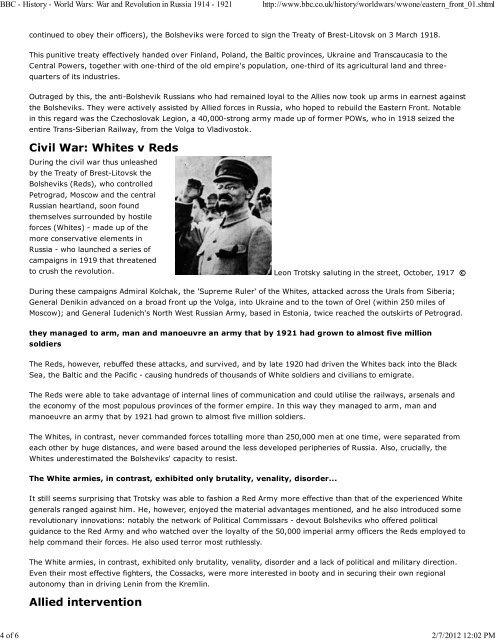War and Revolution in Russia 1914 - 1921 - waughfamily.ca
War and Revolution in Russia 1914 - 1921 - waughfamily.ca
War and Revolution in Russia 1914 - 1921 - waughfamily.ca
You also want an ePaper? Increase the reach of your titles
YUMPU automatically turns print PDFs into web optimized ePapers that Google loves.
BBC - History - World <strong>War</strong>s: <strong>War</strong> <strong>and</strong> <strong>Revolution</strong> <strong>in</strong> <strong>Russia</strong> <strong>1914</strong> - <strong>1921</strong>http://www.bbc.co.uk/history/worldwars/wwone/eastern_front_01.shtml4 of 6 2/7/2012 12:02 PMcont<strong>in</strong>ued to obey their officers), the Bolsheviks were forced to sign the Treaty of Brest-Litovsk on 3 March 1918.This punitive treaty effectively h<strong>and</strong>ed over F<strong>in</strong>l<strong>and</strong>, Pol<strong>and</strong>, the Baltic prov<strong>in</strong>ces, Ukra<strong>in</strong>e <strong>and</strong> Trans<strong>ca</strong>u<strong>ca</strong>sia to theCentral Powers, together with one-third of the old empire's population, one-third of its agricultural l<strong>and</strong> <strong>and</strong> threequartersof its <strong>in</strong>dustries.Outraged by this, the anti-Bolshevik <strong>Russia</strong>ns who had rema<strong>in</strong>ed loyal to the Allies now took up arms <strong>in</strong> earnest aga<strong>in</strong>stthe Bolsheviks. They were actively assisted by Allied forces <strong>in</strong> <strong>Russia</strong>, who hoped to rebuild the Eastern Front. Notable<strong>in</strong> this regard was the Czechoslovak Legion, a 40,000-strong army made up of former POWs, who <strong>in</strong> 1918 seized theentire Trans-Siberian Railway, from the Volga to Vladivostok.Civil <strong>War</strong>: Whites v RedsDur<strong>in</strong>g the civil war thus unleashedby the Treaty of Brest-Litovsk theBolsheviks (Reds), who controlledPetrograd, Moscow <strong>and</strong> the central<strong>Russia</strong>n heartl<strong>and</strong>, soon foundthemselves surrounded by hostileforces (Whites) - made up of themore conservative elements <strong>in</strong><strong>Russia</strong> - who launched a series of<strong>ca</strong>mpaigns <strong>in</strong> 1919 that threatenedto crush the revolution.Leon Trotsky salut<strong>in</strong>g <strong>in</strong> the street, October, 1917 ©Dur<strong>in</strong>g these <strong>ca</strong>mpaigns Admiral Kolchak, the 'Supreme Ruler' of the Whites, attacked across the Urals from Siberia;General Denik<strong>in</strong> advanced on a broad front up the Volga, <strong>in</strong>to Ukra<strong>in</strong>e <strong>and</strong> to the town of Orel (with<strong>in</strong> 250 miles ofMoscow); <strong>and</strong> General Iudenich's North West <strong>Russia</strong>n Army, based <strong>in</strong> Estonia, twice reached the outskirts of Petrograd.they managed to arm, man <strong>and</strong> manoeuvre an army that by <strong>1921</strong> had grown to almost five millionsoldiersThe Reds, however, rebuffed these attacks, <strong>and</strong> survived, <strong>and</strong> by late 1920 had driven the Whites back <strong>in</strong>to the BlackSea, the Baltic <strong>and</strong> the Pacific - <strong>ca</strong>us<strong>in</strong>g hundreds of thous<strong>and</strong>s of White soldiers <strong>and</strong> civilians to emigrate.The Reds were able to take advantage of <strong>in</strong>ternal l<strong>in</strong>es of communi<strong>ca</strong>tion <strong>and</strong> could utilise the railways, arsenals <strong>and</strong>the economy of the most populous prov<strong>in</strong>ces of the former empire. In this way they managed to arm, man <strong>and</strong>manoeuvre an army that by <strong>1921</strong> had grown to almost five million soldiers.The Whites, <strong>in</strong> contrast, never comm<strong>and</strong>ed forces totall<strong>in</strong>g more than 250,000 men at one time, were separated fromeach other by huge distances, <strong>and</strong> were based around the less developed peripheries of <strong>Russia</strong>. Also, crucially, theWhites underestimated the Bolsheviks' <strong>ca</strong>pacity to resist.The White armies, <strong>in</strong> contrast, exhibited only brutality, venality, disorder...It still seems surpris<strong>in</strong>g that Trotsky was able to fashion a Red Army more effective than that of the experienced Whitegenerals ranged aga<strong>in</strong>st him. He, however, enjoyed the material advantages mentioned, <strong>and</strong> he also <strong>in</strong>troduced somerevolutionary <strong>in</strong>novations: notably the network of Politi<strong>ca</strong>l Commissars - devout Bolsheviks who offered politi<strong>ca</strong>lguidance to the Red Army <strong>and</strong> who watched over the loyalty of the 50,000 imperial army officers the Reds employed tohelp comm<strong>and</strong> their forces. He also used terror most ruthlessly.The White armies, <strong>in</strong> contrast, exhibited only brutality, venality, disorder <strong>and</strong> a lack of politi<strong>ca</strong>l <strong>and</strong> military direction.Even their most effective fighters, the Cossacks, were more <strong>in</strong>terested <strong>in</strong> booty <strong>and</strong> <strong>in</strong> secur<strong>in</strong>g their own regionalautonomy than <strong>in</strong> driv<strong>in</strong>g Len<strong>in</strong> from the Kreml<strong>in</strong>.Allied <strong>in</strong>tervention






![SS Sir Francis [+1917] - waughfamily.ca](https://img.yumpu.com/49438251/1/190x245/ss-sir-francis-1917-waughfamilyca.jpg?quality=85)









